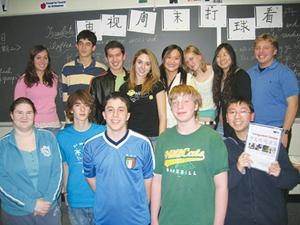 |
|
First-Year Chinese, Arabic Courses at Half-Way Pointby KRISTEN ARMSTRONG, Staff Writer
|
|
| Arlington Public Schools'
effort to introduce Arabic- and Chinese-language classes to the
curriculum is half-way through its first year. In a collaborative program with Northern Virginia Community College that started this fall, Arlington public schools offered students in seventh to 12th grades the opportunity to not just learn the languages, but also to earn college credit in the process. “I like it a lot,” said David Thacker, a student in the H-B Woodlawn Program who enrolled in the high school Chinese course. “I like exploring a new language and learning something different.” There are four language classes being offered through the partnership: middle school and high school Chinese, and middle school and high school Arabic. All told, 58 students enrolled for the program, according to September's figures, though numbers have dwindled a little over the course of the semester. At the middle-school level, Chinese attracted 13 students and Arabic attracted nine. Enrollment for Chinese and Arabic was equal at the high school level, with 18 applicants for each. “We have students from across the county,” said Mary Ann Ulrich, Arlington Public Schools' supervisor of foreign languages. “We have representation from all our middle schools and all our high schools.” The classes meet two times a week after school, for two hours and 20 minutes per session. Students receive one foreign language credit at their home school, as well as 10 college-level credits. The middle school courses are taught at Swanson Middle School, while Washington-Lee High School is the home base for the high school classes. The Arlington school system pays the community college to provide the courses, and the school system also provides bus transportation. Offering evening classes to middle and high school students might seem like a gamble, but Laura Franklin, Northern Virginia Community College's assistant dean for foreign language, recently sat in on a class and noted that “even though the students have been in school the whole day, they're still excited about learning.” Coordinators of the program aim to give students a balanced curriculum. “The classes teach all skills: listening, speaking, writing and also culture,” Franklin said. “We're very interested in getting students proficient in these languages.” But because students are from different grades and have different amounts of exposure to the languages, teachers can find themselves challenged. “Sometimes it's hard to accommodate students of different levels,” said Yun-Chi Maggie Hsu, the high school Chinese teacher. “It's a mix of levels and it can be difficult to assess students' needs.” In Hsu's class, there is a good number of beginners, but also some students who had previous knowledge of the language. Yorktown High School student James Randle has lived in Beijing, and took the course because he “wanted to beef up his Chinese before college.” Washington-Lee siblings Chi-Hang Au and Queenie Au moved from Hong Kong four years ago, and already know how to read characters. No matter what level of proficiency the students brought to the class, the courses are no walk in the park, they say. “The workload is very demanding,” Hsu said. “You have to be mature to maintain consistency.” School Board members agreed to the partnership last year, rather than attempt to start up language classes in Chinese and Arabic on their own. Several School Board members had pressed for inclusion of the languages into the curriculum, saying it was not smart to leave out languages that are becoming more important, while adding courses in languages, such as Italian, that have less relevance in the 21st-century world. |
 Members of the high school Chinese-language course being taught as a collaborative effort between Arlington Public Schools and Northern Virginia Community College. (Photo by Kristen Armstrong) |